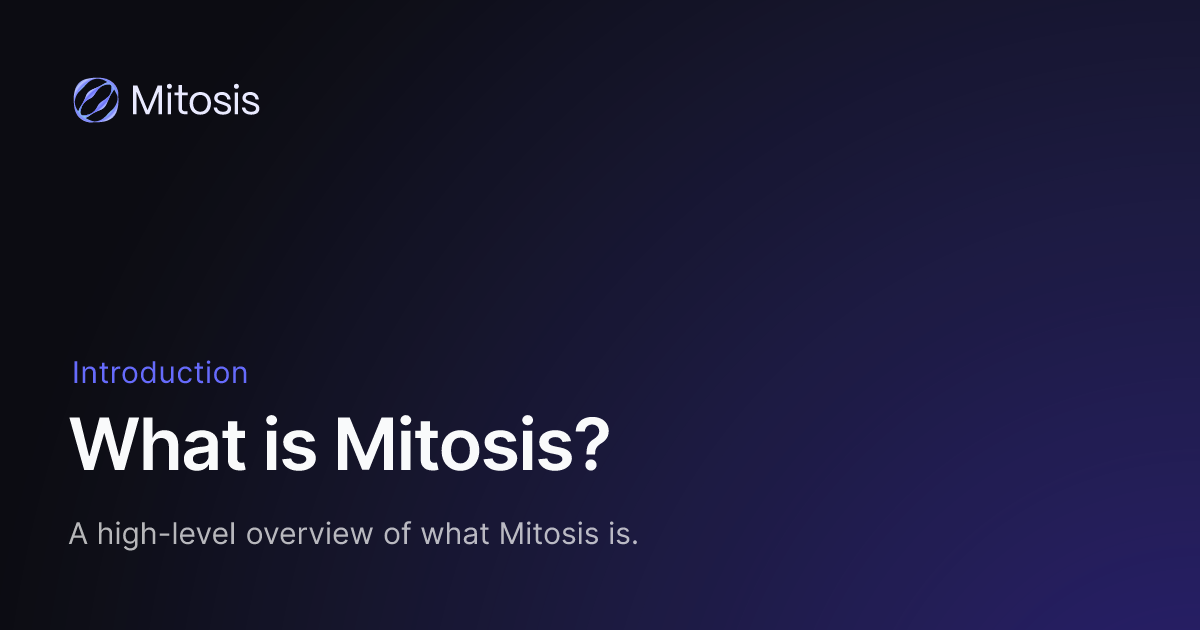CFTC’s Spot Crypto Shift: Institutional Access, DeFi Liquidity, and Mitosis’s Cross-Chain Edge

Introduction: A Federal Green Light for Crypto Spot Trading
Signage outside the U.S. CFTC headquarters in Washington, D.C., signaling a historic shift in crypto policy.
On August 5, 2025, U.S. regulators sent ripples through the crypto world. The Commodity Futures Trading Commission (CFTC) announced it is considering allowing spot crypto asset trading on federally registered futures exchanges. In plain terms, this means well-established futures platforms could list actual Bitcoin, Ether, and other digital assets for direct trading, not just derivatives. This “listed spot crypto trading initiative” – launched in response to a presidential working group on digital assets – aims to finally provide regulatory clarity on how and where cryptocurrencies can trade in the U.S.. Acting CFTC Chairman Caroline Pham framed it as a collaborative effort, inviting stakeholders to help shape guidelines for listing spot crypto contracts on these exchanges. The message was clear: U.S. authorities are moving toward integrating crypto with the traditional market structure rather than keeping it at arm’s length.
Why is this such a big deal? For one, it marks a dramatic policy shift that could open the floodgates for institutional participation in crypto. A regulated pathway for spot trading means large banks, asset managers, and pension funds – many of whom were sitting on the sidelines – may finally feel confident to dive in. “This is a significant development, not just for the U.S. but for global markets,” noted one exchange executive, underscoring that aligning crypto with traditional market standards could drive broader participation from institutions worldwide. Indeed, the CFTC’s move brings crypto one step closer to the structure and standards of traditional markets, potentially inviting the same kind of players and liquidity that trade commodities or equities. Secondly, handing the CFTC primary oversight of spot crypto would clarify the long-murky question of “who’s in charge” for digital assets. The industry has long clamored for such clarity, since the regulatory tug-of-war (with the SEC often calling many tokens securities) created confusion and risk. Now, by positioning the CFTC as a lead regulator for crypto commodities (like Bitcoin and beyond), the U.S. is signaling that it wants to establish clear rules of the road – treating sufficiently decentralized tokens more like commodities than securities. This clarity is expected to be a “game changer” that unlocks further institutional adoption, as firms gain confidence the assets they handle won’t suddenly be deemed unlawful. Finally, a CFTC green light could significantly boost market liquidity. If spot crypto trading migrates onto regulated exchanges with deep pockets and robust infrastructure, it can attract vast new pools of capital. More buyers and sellers on compliant venues means tighter spreads and deeper order books. Market makers who hesitated to operate on unregulated offshore platforms might pile into U.S. exchanges once clear rules and oversight are in place. Over time, we could see a broader range of cryptocurrencies beyond just Bitcoin and Ether entrenched on U.S. soil – something analysts say moves like this will help accelerate. In short, this policy shift stands to normalize crypto within the U.S. financial system, marrying the innovation of DeFi and digital assets with the legitimacy (and constraints) of traditional finance.
In the sections below, we’ll break down how this potential CFTC policy change could reshape the crypto and DeFi landscape, especially in terms of institutional access, regulatory clarity, and liquidity flows. We’ll then dive into what it all means for Mitosis – the network for programmable liquidity – examining how a more regulated, capital-rich environment might empower Mitosis’s cross-chain ecosystem to thrive.

Institutional Access and Regulatory Clarity: Bridging TradFi and Crypto
For years, institutional investors have craved greater regulatory certainty before fully embracing crypto. The CFTC’s willingness to supervise spot trading on designated exchanges delivers exactly that. It effectively hands crypto its “seal of approval” as a mainstream asset class. With clearer jurisdiction (CFTC for commodities, SEC for securities) and new laws like the proposed CLARITY Act delineating digital assets, the fear of legal backlash is fading. Regulatory clarity isn’t just a buzzword – it’s igniting real capital inflows. In fact, 2025 has seen a dramatic resurgence of crypto investments, with over $60B in new digital asset inflows year-to-date as both institutions and retail return to the market. Analysts largely credit improving U.S. policy for this revival, noting that Congress and regulators are finally defining “rules of the road” that had been missing during the last bull run.
The CFTC’s initiative can be seen as a direct product of this new regulatory environment. It aligns with high-level efforts such as the Digital Asset Market CLARITY Act, which aims to classify crypto assets transparently as either securities or commodities. Under such frameworks, tokens that are sufficiently decentralized or utility-driven would fall under CFTC oversight as commodities, while only investment-contract-like tokens stay with the SEC. The crypto industry has long advocated for this kind of tailored approach, after years of regulation-by-enforcement. Now those efforts are bearing fruit – “the two regulators’ approach marks a significant victory for the crypto industry,” one report observed, given that the CFTC and SEC appear to be coordinating to modernize rules for digital assets. The result is growing confidence in the U.S. as a viable, innovation-friendly jurisdiction for crypto. In the words of CFTC’s Pham, “Together, we will make America the crypto capital of the world.”. That kind of pro-growth rhetoric, coupled with concrete actions like this spot trading plan, suggests the U.S. is shedding its “wild west” ambiguity and embracing a more constructive regulatory stance.
Institutional access stands to benefit enormously. Consider the mindset of a large traditional fund: Previously, even if they believed in crypto’s upside, they faced practical hurdles – lack of regulated venues, custodial worries, unclear laws. If the CFTC enables spot trading on, say, CME or ICE’s platforms, those hurdles diminish. Institutions could trade crypto with the same confidence as trading gold or oil futures. According to market leaders, this brings crypto closer to traditional market standards and could pull in more sophisticated participants globally. There’s also the matter of new asset listings. Right now, U.S. futures exchanges only list a couple of crypto benchmarks (CME’s Bitcoin and Ether futures). But industry voices hope that with the CFTC’s blessing, a broader range of assets beyond BTC and ETH will entrench themselves on U.S. venues in coming years. Imagine being able to directly trade spot Solana, Polygon, or other top altcoins on a regulated exchange – it would be a sea change, integrating many crypto projects into the mainstream financial fold. Each new asset that achieves that status potentially gains access to institutional liquidity and visibility that was previously out of reach.
The knock-on effect for market liquidity and stability could be profound. More institutional participation typically means larger volumes and better liquidity across the board. It also means more arbitrage and convergence between on-chain and off-chain prices. With futures exchanges listing spot crypto, the fragmentation between derivatives and physical markets might diminish, leading to more efficient pricing. Large traders will be able to arbitrage differences between, say, a decentralized exchange price and the futures exchange price of an asset, which helps keep markets aligned. Over time, one could envision crypto markets becoming deeper and less volatile as traditional liquidity pours in – though in crypto “less volatile” is relative! It’s also worth noting that regulatory oversight can build trust, attracting participants who were previously wary of crypto’s unregulated corners. If successful, the CFTC’s plan might gradually siphon trading activity away from offshore exchanges with questionable practices into transparent, U.S.-monitored venues. This could reduce systemic risks (fewer FTX-style implosions) and promote a healthier ecosystem where major price discovery happens in regulated environments with surveillance against manipulation. In short, institutional access and regulatory clarity tend to form a virtuous cycle: clear rules bring in big money, which boosts liquidity and legitimizes the market, which in turn encourages lawmakers to support the space further.
Importantly, these developments don’t happen in a vacuum – they reflect a broader convergence of TradFi and crypto. Even as U.S. regulators warm up to crypto trading, traditional finance is adopting crypto-like practices. For example, the SEC has been pushing same-day settlement and redemptions in traditional markets, a move inspired in part by the 24/7, real-time liquidity norms of crypto. It’s telling that while Wall Street is learning to be faster and more transparent, crypto markets are getting the regulatory seal of approval. The lines are blurring. We’re witnessing a rare moment of cross-pollination where each side is learning from the other’s strengths. In this context, the CFTC’s spot trading green light is another step toward integrating crypto with the traditional financial fabric. President Trump’s administration (under which this CFTC initiative arose) has explicitly made crypto a priority, launching working groups and even dropping prior lawsuits against major exchanges to reset relations. Meanwhile, institutions themselves are increasingly engaging with blockchain-based finance directly – from banks experimenting with tokenized deposits to corporations holding crypto on their balance sheets. All these threads point to one thing: crypto is becoming “normal” in the eyes of finance, and regulated spot trading is a huge leap in that normalization.

A New Era of Market Liquidity and DeFi Evolution
What could this policy shift mean for the broader crypto and DeFi landscape? In a word: liquidity. With institutions entering and clearer rules, we’re likely to see more money flowing through the crypto ecosystem than ever before. Already in 2024-25, venture capital and asset managers have ramped up funding as regulatory clouds began to part. Public markets are excited too – think of Circle’s IPO or the buzz around spot Bitcoin ETFs – all signs that capital is pouring back in. As one strategist put it, U.S. clarity could make the country “even more enticing than Europe for crypto businesses”, reversing the brain drain and investment hesitation of prior years. When you inject tens of billions of new dollars into crypto markets, the first places it shows up are higher asset prices and surging on-chain activity. Indeed, we’ve recently seen a DeFi renaissance: total value locked (TVL) in DeFi jumped to ~$153B, a three-year high, as fresh capital chased yields across protocols. Ethereum, the largest DeFi hub, saw ETH prices soar ~60% in a month, lifting the value of collateral and positions. But notably, the rally wasn’t confined to Ethereum – Solana, Avalanche, even newer L1s like Sui all enjoyed double-digit TVL growth, signaling that opportunities are increasingly cross-chain. In other words, crypto’s growth is expanding outward, not just upward, as investors seek returns on multiple networks.
This is where the CFTC’s move and DeFi intersect. Market liquidity from institutional inflows doesn’t just pump prices; it fuels the whole DeFi engine. More liquidity means more capital to deploy in lending pools, more collateral for borrowing, and more liquidity to facilitate trades on DEXs (decentralized exchanges). A key trend has been the rise of sophisticated yield strategies – like looping stablecoin loans across protocols to earn 20%+ APY. Such strategies thrive when liquidity is ample, because arbitrage and high-yield opportunities are more abundant in a bull market flush with cash. If regulated spot trading brings a wave of new entrants, we can expect a flurry of DeFi activity as well. Many institutional players won’t limit themselves to just buying and holding crypto; they’ll look to put that capital to work. In fact, one likely scenario is big institutions using stablecoins (now blessed by law via the GENIUS Act’s federal stablecoin regime) to participate in DeFi lending and yield farming. With stablecoins explicitly recognized and backed by 100% reserves under new U.S. law, holding and using tokens like USDC is now far more palatable to risk managers. As a result, we’re already seeing stablecoin usage explode – over half of the ~$250B stablecoin supply circulates on Ethereum alone as of mid-2025. More trust in stablecoins directly translates to more dry powder for DeFi, since these are the units of account for most on-chain trades and farms.
Crucially, regulatory clarity also broadens the spectrum of DeFi collaborations. In the fog of uncertainty, many TradFi institutions avoided touching DeFi protocols. But with clear guidelines, we’re poised to see more bridges between centralized finance and decentralized finance. For example, real-world asset (RWA) tokenization is an area gaining momentum – bond ETFs, real estate funds, and Treasury bills are being tokenized on Ethereum and other networks. As Wall Street converges with crypto (seeking compliant chains to host these assets), Ethereum’s role as the settlement layer for tokenized assets is growing. A recent projection by Mitosis University analysts suggested tokenized real-world assets could soon become as common in DeFi as stablecoins, bringing trillions of dollars of value on-chain over time. If the CFTC’s initiative helps solidify Ethereum and similar chains as regulated commodity networks, it will only accelerate the RWA trend. Imagine a future where a tokenized bond trades on a regulated exchange and can be used as collateral in a DeFi lending pool the same day. We’re already inching in that direction: companies like Franklin Templeton and WisdomTree have experimented with on-chain funds, and corporations like BitMine and BitDigital are holding and staking ETH precisely because they foresee a tokenized financial system taking root.
All these developments point toward a more unified crypto-financial system – one where traditional and decentralized liquidity merge. But ironically, even as DeFi grows, it faces a classic problem: fragmentation. DeFi may be decentralized, but it hasn’t been unified – liquidity is fragmented and stuck in each chain’s walled garden. Each blockchain ecosystem (Ethereum, Solana, Avalanche, etc.) traditionally operated like an island, with its own pools of liquidity and yield opportunities that were hard to access from the outside. Bridging funds from one to another was often clunky, expensive, and risky, as many users learned through painful bridge hacks or long wait times. This fragmentation means that even if total liquidity is high, it’s inefficiently scattered, leading to higher slippage in trades and lots of idle capital. For example, you might have a surplus of dollars earning 2% on one chain while another chain has a lending pool paying 8% that lacks liquidity. In legacy markets, large institutions arbitrage such differences quickly, but in crypto, chain silos made that difficult for regular users.
Thankfully, the next evolution of DeFi – especially in a liquidity-rich era – is about breaking down those silos. And this is where Mitosis’s cross-chain liquidity network becomes a game-changer.

Empowering the Mitosis Ecosystem in a Regulated, Cross-Chain Future
Mitosis is a Layer-1 blockchain purpose-built to unify liquidity across networks. Often dubbed “the network for programmable liquidity,” Mitosis acts as a universal liquidity layer that connects multiple blockchains, allowing value to move freely among them. At a high level, you can think of Mitosis as a liquidity router for DeFi: instead of juggling assets and bridges manually, a user can deposit funds into Mitosis and get a sort of cross-chain passport (miAssets) that lets them deploy liquidity on any supported chain with ease. Behind the scenes, Mitosis’s Matrix Vaults lock your assets on their origin chain and issue 1:1 representations (e.g. miUSDC, miETH) that are usable across the ecosystem. With those, you can instantly tap opportunities on various chains – e.g. deposit USDC on Ethereum, receive miUSDC, and allocate it to a yield farm on Polygon or a lending market on Avalanche without ever dealing with separate bridges or exchanges. Mitosis handles the cross-chain settlement via secure fast-finality messaging (using tech like Hyperlane), so transfers happen quickly and with robust safety checks. In essence, Mitosis builds “liquidity highways, not toll booths,” enabling capital to flow freely instead of getting stuck at each chain’s border.
In a world where the CFTC’s policy brings in a wave of new capital and interest, Mitosis’s mission becomes even more vital. More institutional money entering crypto means a greater need for efficient deployment of liquidity across many blockchain ecosystems. Mitosis is uniquely suited for this task: it unifies liquidity into a single programmable layer across multiple networks, exactly what big players will want as they explore yields beyond just Bitcoin and Ethereum. Consider an institution that, thanks to regulatory clarity, now feels comfortable holding a large amount of USDC (since stablecoins are officially legitimized). Previously, that institution might have left those funds in a bank or a single-chain protocol. But with a platform like Mitosis, they could allocate that USDC into Mitosis’s vaults to earn yield on multiple chains simultaneously. For example, some portion could be providing liquidity on a Solana DEX, another portion lending on an Arbitrum vault, another farming on a Cosmos appchain – all coordinated through one interface. Mitosis’s design effectively embeds a liquidity marketplace in each connected network, so it can deploy assets across ecosystems to wherever returns are highest, without the user micromanaging each move. This kind of cross-chain yield optimization will be incredibly appealing as crypto markets deepen. It means higher capital efficiency (no more idle pockets on one chain while another chain has shortages), and it boosts overall DeFi liquidity by making it easy for funds to flow to needed spots. Indeed, as more liquidity flows into Mitosis, the network’s security and throughput strengthen – the protocol can scale volume and generate more fees, which in turn rewards liquidity providers and stakers in the Mitosis ecosystem. In short, rising crypto tides directly feed into Mitosis’s liquidity engine, enabling it to deliver even more value back to users.
Regulatory clarity also has direct empowering effects on Mitosis’s community and governance. Mitosis isn’t just a cross-chain bridge; it’s a community-driven DeFi platform where liquidity providers hold governance tokens (like $MITO and miAsset tokens) that let them vote on protocol decisions. In the past, uncertainty around whether governance tokens might be deemed “unregistered securities” cast a chill on some participants. But now, with laws likely distinguishing utility tokens vs. securities, community members can feel more confident engaging in Mitosis governance without legal fear. As one Mitosis University analysis noted, clearer rules mean Mitosis’s core tokens face less ambiguity – if MITO and miAssets are viewed as utility tokens for a decentralized liquidity network (not investment contracts), it opens doors for wider exchange listings and even institutional holding of these assets. We could realistically see a U.S. exchange listing MITO in the future if it meets regulatory criteria, greatly broadening access and liquidity for the token. That kind of legitimacy would invite more participants – even institutional players like crypto funds or DAOs – to get involved in Mitosis’s governance and long-term development. The project’s “Ecosystem-Owned Liquidity” model (where the community collectively owns and manages liquidity) aligns well with the long-term mindset of institutional players who value stability over mercenary capital. As regulations validate these decentralized models, Mitosis’s forum and DAO can thrive, with higher engagement and richer proposals, ultimately creating a smarter, more robust community.
Another area where Mitosis shines in this new landscape is as a “connective tissue” between TradFi and DeFi. With big institutions finally ready to collaborate, there’s demand for infrastructure that can bridge compliant, permissioned environments and the open crypto world. Mitosis can serve this role elegantly. For instance, imagine a large bank tokenizing a portfolio of loans on a private chain, and wanting to channel some of that capital into public DeFi protocols for yield. Through Mitosis, that bank’s tokenized assets (or stablecoins) could be routed into various on-chain opportunities – lending pools, liquidity farms, etc. – all while respecting any needed compliance checks. Mitosis’s chain-agnostic design and intent-based automation can be extended with rule-sets that satisfy institutional requirements (such as only deploying to whitelisted pools or adhering to certain risk parameters). In effect, Mitosis can provide a safe bridge for institutional money to engage with DeFi, acting as the intermediary that speaks both languages. We already see more partnerships on the horizon: regulated DeFi pools (like permissioned Aave markets) and real-world asset platforms will need cross-chain liquidity to truly succeed, and Mitosis stands ready to supply it.
Furthermore, as new blockchains and Layer-2 networks launch – now with greater regulatory blessings – Mitosis helps them avoid the dreaded “cold start” problem by instantly connecting them into a unified liquidity network. In the past, a new L1 might struggle for months to attract TVL. With Mitosis, that chain can plug in and access a share of liquidity from day one, as the protocol automatically rebalances funds to productive venues. Mitosis has already explored synergies with Ethereum rollups like Optimism, envisioning an interconnected “superchain” where liquidity moves seamlessly across many execution layers. In a climate of regulatory certainty, these cross-chain partnerships become easier to execute (legal doubts no longer slow things down). The endgame is a more interoperable, resilient DeFi landscape where users barely notice which chain they’re on – they simply access the best opportunities, and Mitosis handles the rest. As institutional money comes in, the demand for smoother interoperability and risk-managed platforms will soar, and that is exactly what Mitosis delivers with its automated, security-focused liquidity management.
Lastly, the CFTC’s crypto push underscores the importance of security and resilience, which Mitosis has prioritized from inception. In a highly cross-connected multi-chain world, the weakest link can cause cascading failures (as we’ve seen with bridge hacks). Mitosis addresses this by forgoing custodial bridges in favor of secure cross-chain messaging and light-client verification. As the stakes get higher – billions of dollars flowing across chains – this robust approach is likely to attract users and institutions who demand assurance that their transfers won’t be the next exploit. A recent example that highlights the need for resilient liquidity infrastructure was Galaxy Digital’s $2B Bitcoin move, which rocked markets and tested liquidity pools’ capacity. Huge whale trades can cause short-term chaos, but a network like Mitosis can help cushion volatility by quickly routing liquidity where it’s needed (e.g. moving stablecoin liquidity to exchanges where sell-offs are happening, or enabling arbitrage that evens out price dislocations). As one observer quipped, even in a bull run, crypto can “trade like a meme stock when whales cough”, meaning sudden shocks are inevitable. The real question is whether our infrastructure can handle those shocks gracefully. Mitosis contributes to DeFi resilience by connecting liquidity pools across chains, so a drain on one platform could be offset by funds from another, and traders can rebalance swiftly via the cross-chain highway. In the long run, this makes the whole system more robust against isolated stresses – a goal very much in line with the regulatory push for stronger market infrastructure.

Conclusion: A Unified, Liquid Future for Crypto and DeFi
The CFTC’s potential approval of spot crypto trading on registered exchanges represents a watershed moment in crypto’s maturation. It promises to open the doors for institutional players to engage with digital assets on familiar, regulated turf – a development that could flood the crypto market with new capital, boost liquidity, and legitimize DeFi in the eyes of traditional finance. By providing long-sought regulatory clarity, U.S. policymakers are effectively extending an olive branch to the crypto industry: inviting innovation to flourish under a framework that protects investors without stifling progress. This new era of clarity and access will likely accelerate trends already underway – from the mainstreaming of stablecoins and tokenized real-world assets, to the blending of TradFi and DeFi practices in pursuit of real-time, always-on finance. We can expect more institutions to not only buy crypto, but to use it: staking ETH in corporate treasuries, providing liquidity on decentralized platforms, and integrating blockchain networks into their core operations. In parallel, DeFi protocols will adapt to serve this growing wave of users who demand flexibility, security, and compliance-friendliness.
Within this transformative landscape, Mitosis is poised to play a pivotal role. By tearing down the walls between chains, Mitosis enables the crypto ecosystem to function as a unified whole – precisely what’s needed when large-scale capital floods in seeking efficient deployment. If the next chapter of crypto is about interconnectedness (between old finance and new, between siloed networks, between real assets and virtual ones), then Mitosis’s cross-chain liquidity infrastructure is a key piece of the puzzle. It allows liquidity to flow to where it’s needed most without friction, making the entire DeFi market more fluid and effective. For regular users, this means an easier time chasing the best yields or diversifying into new chains without the usual headaches. For institutions, it means a ready-made solution to maximize returns on their digital assets across the multichain universe – all while maintaining the oversight and risk controls they require. And for the crypto industry at large, it means higher capital efficiency and resilience: liquidity isn’t stranded or underutilized, and shocks can be absorbed by redistributing capital swiftly through Mitosis’s “liquidity highways.” The vision of an always-on, global financial system – one that the SEC itself is inching toward with faster settlements – is already reality in DeFi, and Mitosis is helping extend that reality across networks and into mainstream finance.
In sum, the CFTC’s crypto initiative could herald a new chapter where regulated markets and DeFi ecosystems grow in tandem, each reinforcing the other. As America sets the stage for crypto trading under its regulatory umbrella, institutional and retail participants alike will gain unprecedented access to this asset class. The broader crypto market will likely become more liquid, more diverse, and more interconnected than ever. Amid this progress, Mitosis stands out as an enabler – a catalyst that takes the influx of capital and clarity and channels it into a composable, cross-chain future. With the “rules of the road” finally coming into focus, projects like Mitosis can innovate with greater confidence, helping ensure that the next wave of crypto adoption isn’t confined to single networks or siloed experiences. Instead, if Mitosis has its way, that wave will wash across the entire Web3 ecosystem, linking chains and communities through a fast, secure, and composable liquidity layer. And as the dust settles, we may look back on 2025 as the year crypto turned a corner – when regulators gave their nod, institutions dove in, and the crypto universe, with Mitosis at the helm of its cross-chain ships, truly began to sail as one.
Glossary: CFTC (Commodity Futures Trading Commission), DeFi (Decentralized Finance), TVL (Total Value Locked), Stablecoin, Cross-Chain Liquidity, Layer-1, Layer-2, RWA (Real-World Assets), DEX (Decentralized Exchange), miAsset (Mitosis asset token).
Internal Links: Learn more about Cross-Chain Liquidity and Mitosis’s programmable liquidity approach, or explore related insights like “DeFi’s TVL Boom Meets Mitosis” and “Digital Asset Inflows Surge to $60B: Regulatory Clarity Empowering Mitosis”.
Useful links:












Comments ()